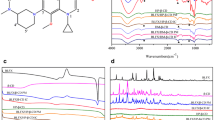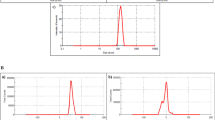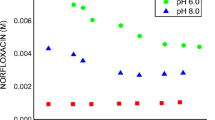Abstract
Chloramphenicol is an old antibiotic agent that is re-emerging as a valuable alternative for the treatment of multidrug-resistant pathogens. However, it exhibits suboptimal biopharmaceutical properties and toxicity profiles. In this work, chloramphenicol was combined with essential amino acids (arginine, cysteine, glycine, and leucine) with the aim of improving its dissolution rate and reduce its toxicity towards leukocytes. The chloramphenicol/amino acid solid samples were prepared by freeze-drying method and characterized in the solid state by using Fourier transform infrared spectroscopy, powder X-ray diffraction, differential scanning calorimetry, scanning electron microscopy, and solid-state nuclear magnetic resonance. The dissolution properties, antimicrobial activity, reactive oxygen species production, and stability of the different samples were studied. The dissolution rate of all combinations was significantly increased in comparison to that of the pure active pharmaceutical ingredient. Additionally, oxidative stress production in human leukocytes caused by chloramphenicol was decreased in the chloramphenicol/amino acid combinations, while the antimicrobial activity of the antibiotic was maintained. The CAP:Leu binary combination resulted in the most outstanding solid system makes it suitable candidate for the development of pharmaceutical formulations of this antimicrobial agent with an improved safety profile.









Similar content being viewed by others
References
Falagas ME, Grammatikos AP, Michalopoulos A. Potential of old-generation antibiotics to address current need for new antibiotics. Expert Rev Anti-Infe. 2008;6(5):593–600.
Stratton CW. Chloramphenicol. Antimicrob Infect Dis Newsl. 2002;18(12):89–91.
Sweetman SC, Blake PS. Martindale: the complete drug reference. 36th ed. London: Pharmaceutical Press; 2009.
Liaqat I, Sumbal F, Sabri AN. Tetracycline and chloramphenicol efficiency against selected biofilm forming bacteria. Curr Microbiol. 2009;59(2):212–20.
Moffa M, Brook I. 26 - Tetracyclines, glycylcyclines, and chloramphenicol. In: Bennett JE, Dolin R, Blaser MJ, editors. Mandell, Douglas, and Bennett′s Principles and Practice of. Infectious Diseases. 8th ed. Philadelphia: Saunders; 2015. p. 322–38.
Singh R, Sripada L, Singh R. Side effects of antibiotics during bacterial infection: mitochondria, the main target in host cell. Mitochondrion. 2014;16:50–4.
Rodríguez-Spong B. General principles of pharmaceutical solid polymorphism A supramolecular perspective. Adv Drug Deliv Rev. 2004;56(3):241–74.
Kawabata Y, Wada K, Nakatani M, Yamada S, Onoue S. Formulation design for poorly water-soluble drugs based on biopharmaceutics classification system: basic approaches and practical applications. Int J Pharm. 2011;420(1):1–10.
Aitipamula S, Banerjee R, Bansal AK, Biradha K, Cheney ML, Choudhury AR, et al. Polymorphs, salts, and cocrystals: what’s in a name? Cryst Growth Des. 2012;12(5):2147–52.
Balk A, Wiest J, Widmer T, Galli B, Holzgrabe U, Meinel L. Transformation of acidic poorly water soluble drugs into ionic liquids. Eur J Pharm Biopharm. 2015;94:73–82.
Thakuria R, Delori A, Jones W, Lipert MP, Roy L, Rodríguez-Hornedo N. Pharmaceutical cocrystals and poorly soluble drugs. Int J Pharm. 2013;453(1):101–25.
Crini G. Review: a history of cyclodextrins. Chem Rev. 2014;114(21):10940–75.
Loftsson T, Brewster ME. Cyclodextrins as functional excipients: methods to enhance complexation efficiency. J Pharm Sci. 2012;101(9):3019–32.
Löbmann K, Grohganz H, Laitinen R, Strachan C, Rades T. Amino acids as co-amorphous stabilizers for poorly water soluble drugs—part 1: preparation, stability and dissolution enhancement. Eur J Pharm Biopharm. 2013;85(3, Part B):873–81.
Löbmann K, Laitinen R, Strachan C, Rades T, Grohganz H. Amino acids as co-amorphous stabilizers for poorly water-soluble drugs—part 2: molecular interactions. Eur J Pharm Biopharm. 2013;85(3, Part B):882–8.
Löbmann K, Strachan C, Grohganz H, Rades T, Korhonen O, Laitinen R. Co-amorphous simvastatin and glipizide combinations show improved physical stability without evidence of intermolecular interactions. Eur J Pharm Biopharm. 2012;81(1):159–69.
Grohganz H, Priemel PA, Löbmann K, Nielsen LH, Laitinen R, Mullertz A, et al. Refining stability and dissolution rate of amorphous drug formulations. Expert Opin Drug Del. 2014;11(6):977–89.
Kanaujia P, Poovizhi P, Ng WK, Tan RBH. Amorphous formulations for dissolution and bioavailability enhancement of poorly soluble APIs. Powder Technol. 2015;285:2–15.
Aiassa V, Zoppi A, Albesa I, Longhi MR. Inclusion complexes of chloramphenicol with β-cyclodextrin and aminoacids as a way to increase drug solubility and modulate ROS production. Carbohydr Polym. 2015;121:320–7.
Aiassa V, Zoppi A, Becerra MC, Albesa I, Longhi MR. Enhanced inhibition of bacterial biofilm formation and reduced leukocyte toxicity by chloramphenicol:β-cyclodextrin:N-acetylcysteine complex. Carbohydr Polym. 2016;152:672–8.
Harris RK. Nuclear magnetic resonance spectroscopy. London: Longman Scientific and Technical; 1994.
The United States Pharmacopeia (USP 30). Rockville, MD 2007.
US Department of Health and Human Services FaC. Guidance for industry. Dissolution testing of immediate release solid oral dosage forms. 1997.
Zuorro A, Fidaleo M, Lavecchia R. Solubility enhancement and antibacterial activity of chloramphenicol included in modified β-cyclodextrins. B Kor Chem Soc. 2010;31(11):3460–2.
Zołek T, Paradowska K, Krajewska D, Rózański A, Wawer I. 1H, 13C MAS NMR and GIAO-CPHF calculations of chloramphenicol, thiamphenicol and their pyrrole analogues. J Mol Struct. 2003;646(1–3):141–9.
Tadeusiak EJ, Ciesielski W, Olejniczak S. Determination of enantiomeric excess of leucine by 13C CP-MAS solid-state NMR. Appl Magn Reson. 2008;35(1):155–61.
Prakash S, Iturmendi N, Grelard A, Moine V, Dufourc E. Quantitative analysis of Bordeaux red wine precipitates by solid-state NMR: role of tartrates and polyphenols. Food Chem. 2016;199:229–37.
Holt DE, Bajoria R. The role of nitro-reduction and nitric oxide in the toxicity of chloramphenicol. Hum Exp Toxicol. 1999;18(2):111–8.
Eraso AJ, Albesa I. Eriobotrya japonica counteracts reactive oxygen species and nitric oxide stimulated by chloramphenicol. Am J Chin Med. 2007;35(5):875–85.
Gutteridge JMC. Lipid peroxidation and antioxidants as biomarkers of tissue damage. Clin Chem. 1995;41:1819–28.
Stadtman ER, Levine RL. Free radical-mediated oxidation of free amino acids and amino acid residues in proteins. Amino Acids. 2003;25(3):207–18.
Monti GA, Chattah AK, Linck YG. Solid-state nuclear magnetic resonance in pharmaceutical compounds. Ann R NMR S. 2014. p. 221–69.
Acknowledgements
Authors wish to acknowledge the assistance of the Consejo Nacional de Investigaciones Científicas y Técnicas (CONICET) and the Universidad Nacional de Córdoba, both of which provided support and facilities for this investigation. This work was supported by the Fondo para la Investigación Científica y Tecnológica (FONCYT) [Préstamo BID PICT 2013-2150] and the Secretaría de Ciencia y Técnica de la Universidad Nacional de Córdoba (SECyT).
Author information
Authors and Affiliations
Corresponding author
Rights and permissions
About this article
Cite this article
Sterren, V.B., Aiassa, V., Garnero, C. et al. Preparation of Chloramphenicol/Amino Acid Combinations Exhibiting Enhanced Dissolution Rates and Reduced Drug-Induced Oxidative Stress. AAPS PharmSciTech 18, 2910–2918 (2017). https://doi.org/10.1208/s12249-017-0775-4
Received:
Accepted:
Published:
Issue Date:
DOI: https://doi.org/10.1208/s12249-017-0775-4




